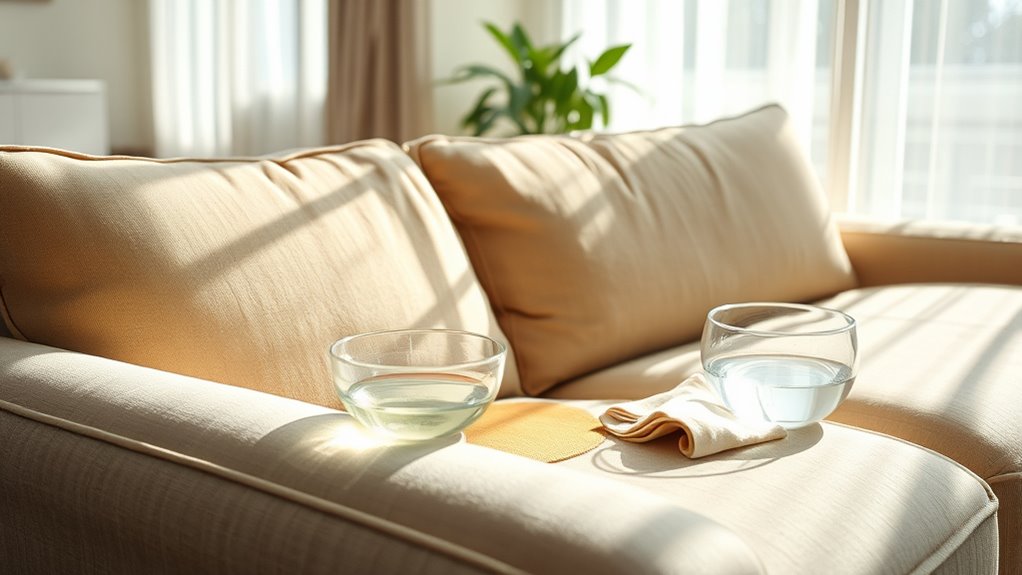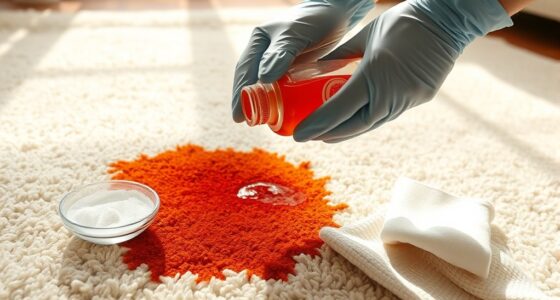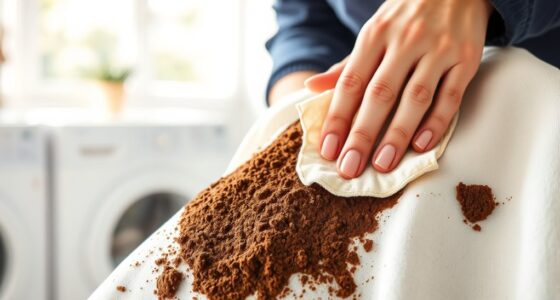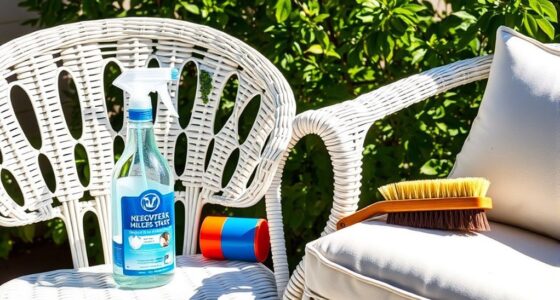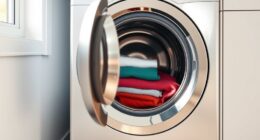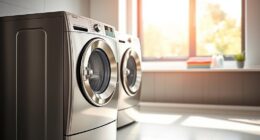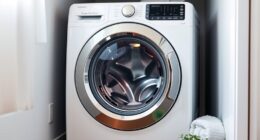To get rid of water stains on upholstery, start by bl blotting the area with a clean, white cloth to absorb moisture. Use a mixture of distilled white vinegar and water to treat the stain, testing it on a hidden spot first. Avoid scrubbing, as this can spread the stain. Once clean, allow the fabric to air dry without heat. For more detailed cleaning techniques and preventative measures, keep exploring!
Key Takeaways
- Blot the stained area with a clean, white cloth to absorb excess moisture immediately after the spill occurs.
- Mix distilled white vinegar with distilled water to create an effective cleaning solution for mineral stains.
- Test any cleaning solution on a hidden area of the fabric to ensure it does not cause damage.
- Gently blot the stain instead of rubbing to prevent spreading and damaging the fabric fibers.
- If stains persist or if mold develops, consider seeking professional cleaning services for thorough treatment.
Understanding Water Stains on Upholstery

Water stains on upholstery can be a frustrating issue, and understanding their causes is key to prevention and removal.
When water dries, it leaves behind minerals like calcium and magnesium that can stain your fabrics. Natural fibers such as cotton and linen absorb water easily, making them particularly susceptible to these marks. Water stains can also redistribute existing dirt or oils in the fabric, creating visible rings.
Even synthetic fabrics like nylon and polyester can develop stains if spills aren’t cleaned up quickly. You’ll find water stains often appear as light brown rings or marks that become more noticeable after drying.
To combat this, regular cleaning and prompt attention to spills are essential. Using distilled water for cleaning can also help avoid adding more mineral deposits to your upholstery.
Immediate Steps to Take After a Spill
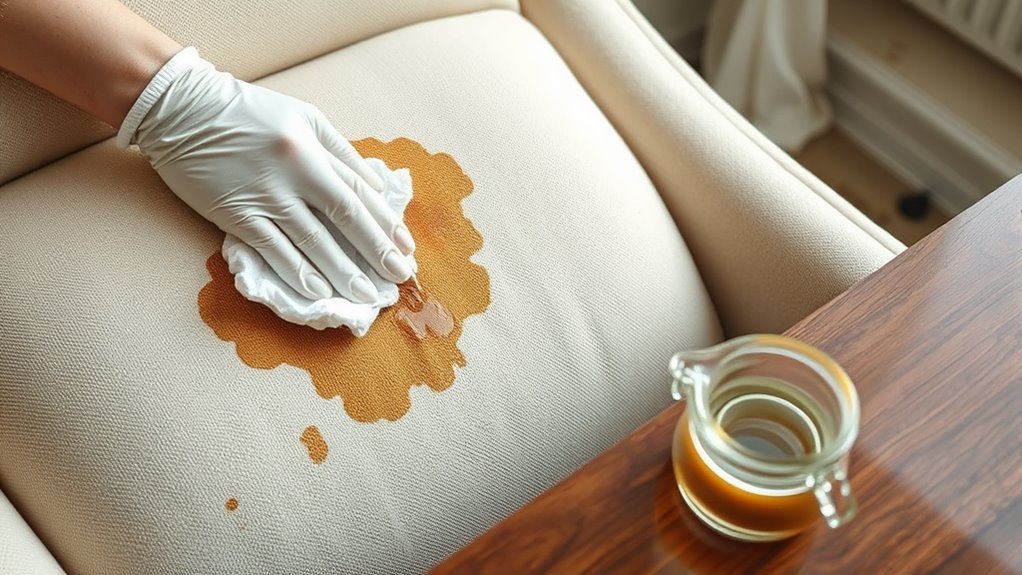
When a spill occurs, taking immediate action is essential to prevent water stains from setting in. Start by using a clean, white cloth to blot the area, absorbing excess moisture without rubbing, which can spread the stain. If there’s standing water, use absorbent towels or a wet/dry vacuum to remove it. Increase airflow by opening windows or using fans to help the upholstery dry naturally. Gather cleaning materials like white vinegar, distilled water, and mild soap for later use. Cold medications may cause additional stains if spilled, so be cautious when using them near upholstery. Continue using absorbent towels to soak up any remaining moisture, and allow the upholstery to air dry without applying heat. Prolonged moisture exposure can increase the likelihood of permanent damage, so the quicker you act, the better your chances of preventing a permanent stain.
Identifying Your Upholstery Fabric
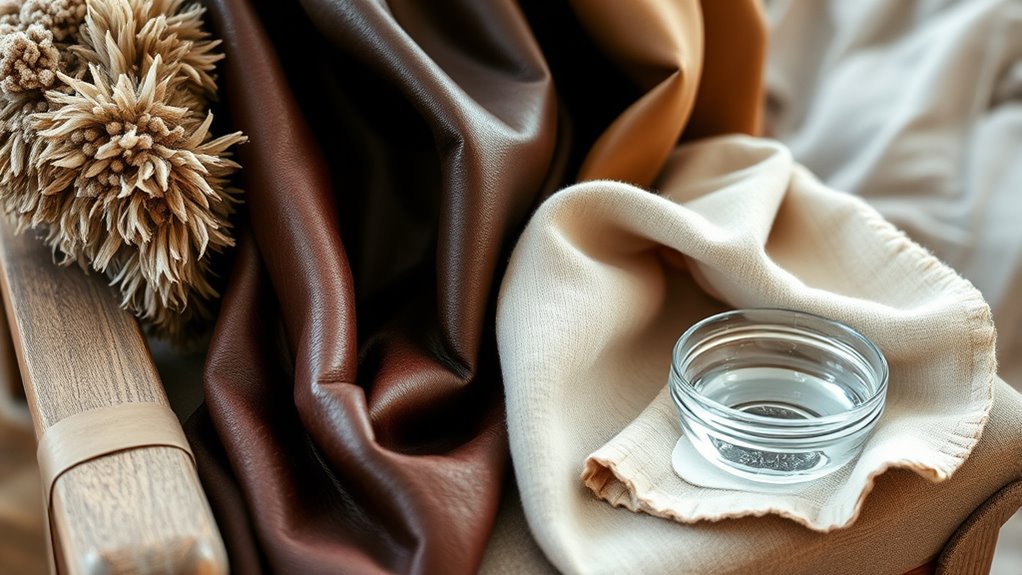
How can you guarantee the right cleaning method for your upholstery? Start by identifying the fabric type. Check if it’s leather, velvet, microfiber, linen, or cotton, as each requires different care.
For instance, leather needs special cleaning to maintain its durability, while velvet calls for delicate treatment to avoid crushing. Use texture analysis to feel the fabric—velvet is plush, and microfiber feels like suede.
Observe the color; natural fibers often have a matte finish. If you’re unsure, look for manufacturer labels that detail fabric composition and cleaning instructions. Additionally, a visual inspection of the fabric can provide initial clues about its type and care requirements.
For a deeper dive, consider conducting burn tests or solvent tests to confirm materials. Knowing your upholstery fabric is key to effective cleaning and avoiding damage.
Essential Cleaning Supplies for Water Stains
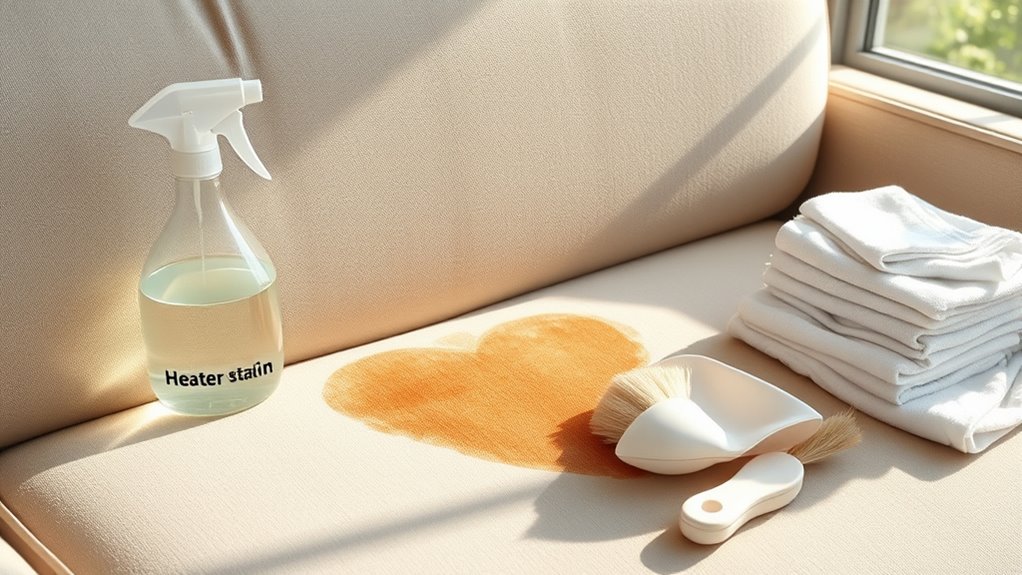
To tackle water stains effectively, you’ll need a few essential cleaning supplies on hand.
To effectively combat water stains, gather essential cleaning supplies for a smoother cleaning experience.
Start with a vacuum cleaner to remove loose dirt and debris from the affected area. Keep clean cloths handy for blotting the stain without spreading it further. A spray bottle is vital for even application of your cleaning solution. Don’t forget a towel for drying the upholstery afterward. Identifying the fabric type is also essential for selecting the most appropriate cleaning method.
To speed up the drying process, use a fan or hair dryer on a low setting. For liquids, distilled water is best to avoid mineral spots, while white vinegar and mild dish soap work wonders on various fabrics.
Having these supplies ready will make your cleaning process much easier and more effective.
Effective Cleaning Solutions for Stains
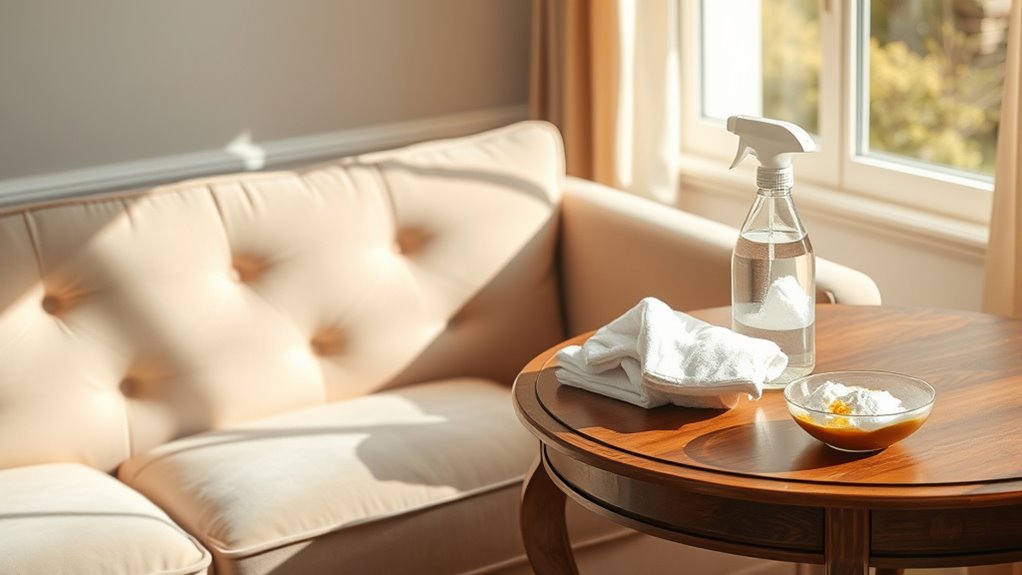
Finding the right cleaning solution for upholstery water stains can make all the difference in restoring your furniture’s appearance.
A simple vinegar solution, mixing distilled white vinegar with distilled water, effectively tackles mineral-based stains. If you prefer something gentler, combine mild dish soap with water for a safe option on most fabrics. Regular maintenance helps keep upholstery looking new and fresh, which is especially important for preventing accumulation of dirt. Eco-friendly alternatives like essential oils can also work wonders. For stubborn stains, consider specialized commercial cleaners designed for upholstery. You can even whip up a DIY fabric cleaner using water, vinegar, and dish soap.
Remember to always test any solution on a hidden area first and apply it lightly with a spray bottle to avoid soaking the fabric. Let it sit briefly before gently scrubbing to maximize effectiveness.
Blotting Techniques for Optimal Results
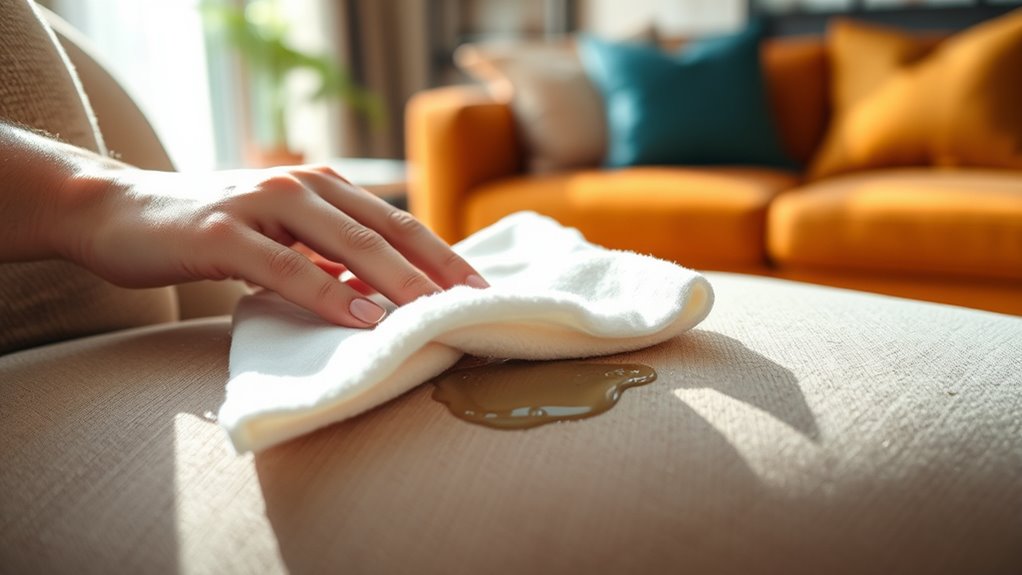
When dealing with water stains on upholstery, it’s crucial to act quickly and use the right blotting techniques for the best results.
Start by blotting from the outer edge of the stain toward the center to contain it. Use clean white cloths or paper towels to avoid color transfer.
Blot the stain from the outer edge inward with clean, white cloths to prevent color transfer.
Apply gentle pressure, particularly on delicate fabrics like silk or velvet, to prevent damage. Different fabrics require distinct cleaning methods to avoid further issues, so always identify the fabric type before proceeding. Frequently switch to a fresh area of the cloth to guarantee effective moisture absorption.
Avoid rubbing, as it can spread the stain, and never use excessive pressure.
Drying Techniques to Prevent Further Staining
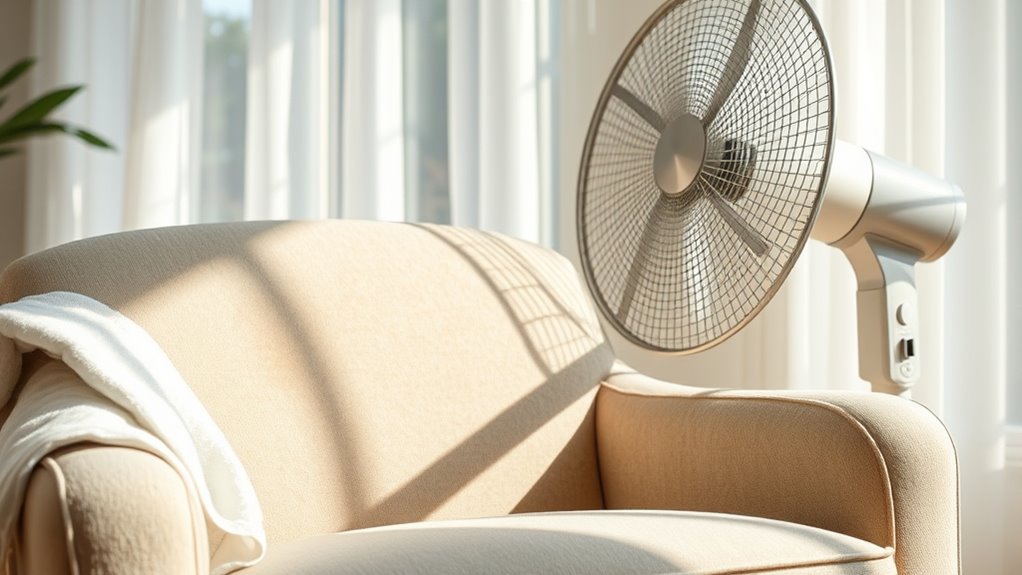
After successfully blotting the water stain, drying the upholstery properly is essential to prevent further damage. Use a hair dryer on a low setting to speed up drying without harming the fabric. Keep the dryer a few inches away and rotate it to guarantee even drying. To enhance air circulation, position fans around the area to help the fabric dry naturally. Avoid high heat, as it can cause further staining or damage. If you’re working with sensitive fabrics, like silk, opt for gentler drying methods. Always test a small, inconspicuous area first. Quick action is crucial because addressing a water stain within the first 24 hours can increase removal success by up to 80%.
Preventative Measures for Future Protection
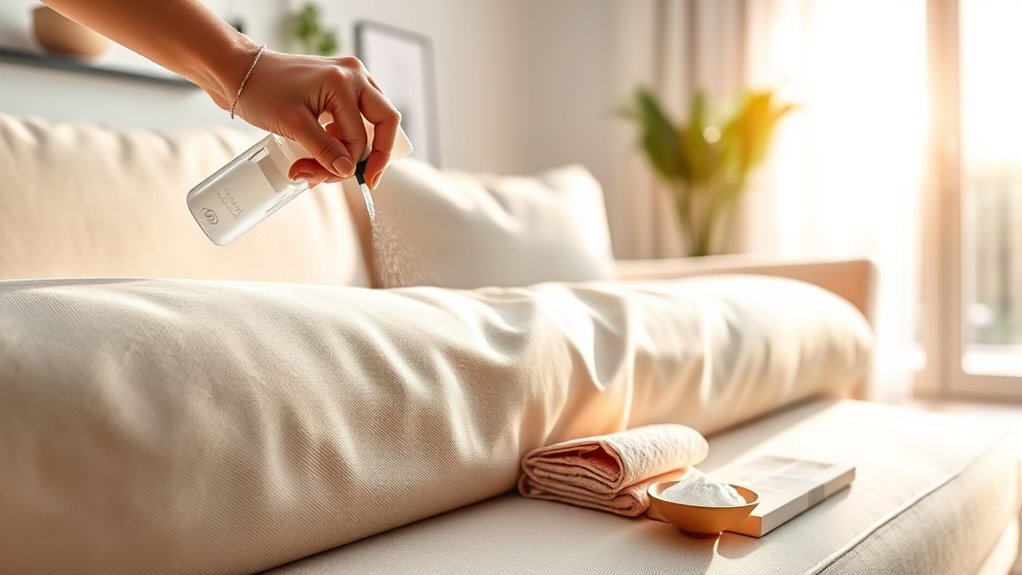
To protect your upholstery from future water stains, implementing a few preventative measures can make a significant difference.
Start with regular vacuuming to remove dust and dirt that can lead to stains. Address spills immediately to prevent them from setting. Use mild detergents instead of harsh chemicals, and opt for specialized upholstery cleaners designed to treat stains without damaging your fabric. Consider applying fabric protectors, which can reduce stain absorption by up to 75%. Always test any cleaning or protective products on a hidden area first to verify compatibility. Additionally, maintain stable humidity levels and avoid direct sunlight to further protect your upholstery from potential water stains and fading. Using distilled white vinegar can also be an effective method for treating any inadvertent water stains that may occur.
Common Mistakes to Avoid When Cleaning
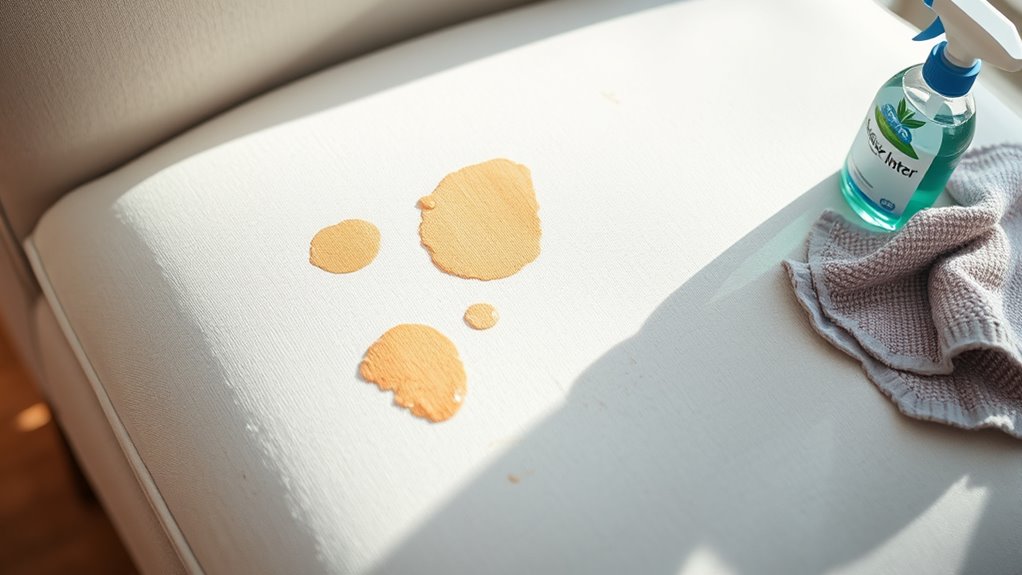
Even with preventative measures in place, mistakes during the cleaning process can lead to unwanted water stains and damage.
One common error is using too much water or soap, which can cause fabric shrinkage or leave a residue that attracts dirt. Avoid over-saturating the fabric, and always rinse thoroughly to eliminate any soap remnants. Excessive soap residue can also result in a dull and dingy appearance, making your upholstery look older than it is.
Using excessive water or soap can lead to fabric shrinkage and unwanted residue. Always rinse thoroughly to avoid these issues.
When spot cleaning, test your solution on a hidden area first and blot gently instead of rubbing, which can spread the stain.
Regular vacuuming with appropriate suction settings is essential to prevent dirt buildup.
Finally, guarantee proper drying methods by using fans and avoiding high heat, as lingering moisture can lead to mold or mildew.
Always inspect your fabric type before cleaning for the best results.
Specialized Cleaning Options for Tough Stains
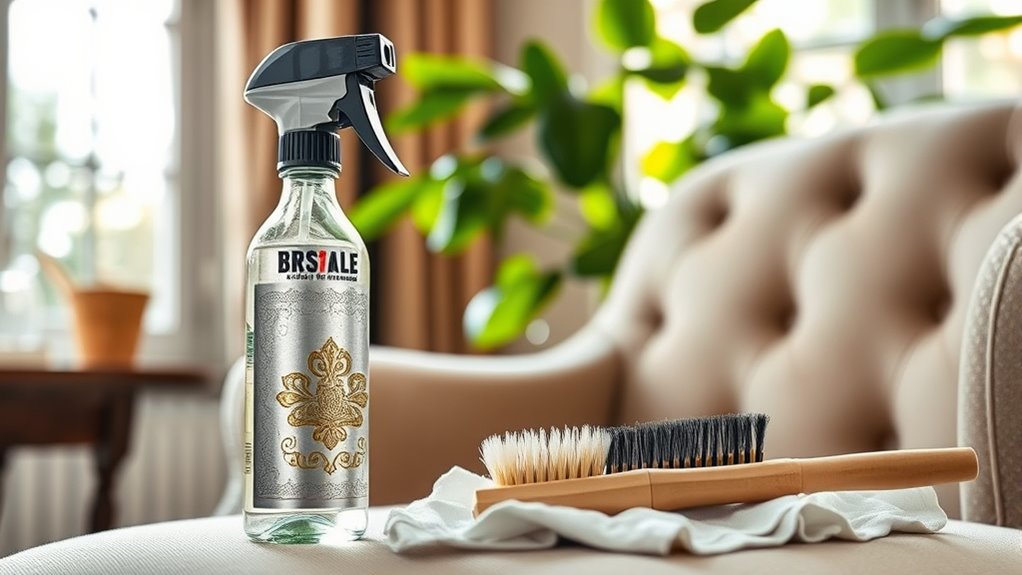
When it comes to tackling tough water stains on upholstery, specialized cleaning options can make all the difference.
Start with household solutions like white vinegar mixed with distilled water; they’re gentle yet effective for mineral deposits. If you’re dealing with specific fabrics like leather or microfiber, invest in upholstery cleaners tailored for those materials. Understanding Water Stains is crucial because it helps identify the source of the discoloration and informs the best cleaning approach.
Steam cleaning can also help—applying gentle heat and moisture loosens stubborn stains without oversaturating the fabric. For lighter stains, foam cleaners lift dirt without excessive soaking.
And remember, if the stains are severe or present alongside mold, hiring a professional is often the best choice to guarantee thorough cleaning and fabric protection.
Always test any solution on a discreet area first!
Frequently Asked Questions
Can I Use Soap on Upholstery to Remove Water Stains?
Yes, you can use soap on upholstery to tackle stains, especially if the fabric is labeled “W” for water-safe.
Just make sure to test it on a hidden area first to avoid any damage. Mild dish soap, like Dawn, works best.
Dampen a microfiber cloth with soapy water, gently dab the area, and rinse with plain water to remove any residue.
Always avoid soaking the fabric to prevent mold or mildew.
How Often Should I Apply Water-Resistant Sprays?
You should apply water-resistant sprays every 6 to 12 months, depending on how much you use your upholstery.
If it’s in a high-traffic area, you might need to reapply more frequently.
Keep an eye on the fabric type, as different materials require different treatment schedules.
Also, consider environmental factors like humidity, which can affect the spray’s longevity.
Regular maintenance can help keep your upholstery protected and looking great.
Are There Eco-Friendly Options for Cleaning Upholstery Stains?
Imagine your upholstery is a canvas, and you’re the artist restoring its beauty.
Yes, there are plenty of eco-friendly options for cleaning upholstery stains! You can use a mix of white vinegar and water for a natural touch or try Castile soap for a gentle cleanse.
Don’t forget baking soda to absorb odors!
What Should I Do if Stains Persist After Cleaning?
If stains persist after cleaning, it’s time to reassess your approach.
Start by identifying the fabric type; certain materials may need specialized care.
You might want to try a vinegar and water mix or a mild dish soap solution for stubborn spots.
If nothing seems to work, consider consulting a professional cleaner who’s the tools and expertise to tackle tough stains effectively.
Can I Steam Clean All Types of Upholstery Fabrics?
You can’t steam clean all types of upholstery fabrics.
While durable fabrics like polyester and cotton are generally safe for steam cleaning, delicate materials like silk, satin, and viscose can get damaged.
Always test a small, hidden area before proceeding.
If you’re unsure about your fabric’s compatibility, it’s best to consult a professional cleaner.
Taking these precautions helps guarantee your upholstery stays in great condition without risking harm from excessive moisture or heat.
Conclusion
Getting rid of water stains on upholstery doesn’t have to feel like a Herculean task. By acting quickly and using the right cleaning solutions, you can restore your furniture’s beauty in no time. Remember to identify your fabric and follow proper drying techniques to avoid any lingering issues. With these tips in hand, you’ll be well-equipped to tackle stains and keep your upholstery looking as good as new—like a showroom masterpiece!
